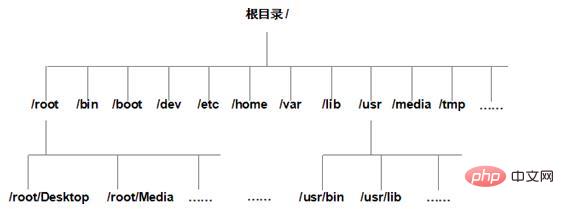
The path in Linux refers to the entire file name and the location of the file. This positioning is called a path; there are two ways to specify the location where a file is stored, namely using absolute paths and relative paths; absolute The path is relative to the root path. As long as the file does not move, its absolute path is constant; while the relative path is relative to the current directory. As the program executes, the current directory may change. , so the relative path of the file is not fixed.

#The operating environment of this tutorial: linux5.9.8 system, Dell G3 computer.
What is the path in Linux?
The location of the path
Includes the entire file name and the location of the file, like this Positioning is called a path
Path is a way to locate files



. #表示的是当前所在的目录 .. #当前目录的上一级目录 ./ #表示当前的目录 . #表示当前的目录 ../ #从当前目录的上一级目录开始 .. #上一级目录
Linux absolute path and relative path detailed explanation
Specify the location where a file is stored. There are two methods, using absolute paths and relative paths.
We know that all files (directories) in the Linux system are organized into an inverted tree structure starting from the root directory "/", as shown in Figure 1.
 Linux system file organization structure diagram
Linux system file organization structure diagram
The absolute path must start from the root directory /. For example, use an absolute path to indicate the location of the bin file. The path should be written as /usr/bin. The test code is as follows:
[root@localhost ~]# bin bash: bin: command not found <-- 没有找到 [root@localhost ~]# /usr/bin bash: /usr/bin: is a directory <-- 是一个文件
Different from absolute paths, relative paths do not start from the root directory /, but start from the current working directory. When using relative paths to indicate the storage location of a file, the two special directories mentioned earlier are often used, namely the current directory (represented by .) and the parent directory (represented by ..).
For example, when we log in to the Linux system as root, the current working directory defaults to /root. If we need to adjust the current working directory to the root subdirectory Desktop, of course we can use the absolute path. , the sample code is as follows:
[root@localhost ~]# pwd <-- 显示当前所在的工作路径 /root [root@localhost ~]# cd /root/Desktop [root@localhost Desktop]# pwd /root/Desktop
[root@localhost ~]# pwd <-- 显示当前所在的工作路径 /root [root@localhost ~]# cd ./Desktop [root@localhost Desktop]# pwd /root/Desktop
To give another example, if you log in to the Linux system as root and convert the current working directory from /root to the /usr directory, there are two ways:
#使用绝对路径 [root@localhost ~]# pwd <-- 显示当前所在的工作路径 /root [root@localhost ~]# cd /usr [root@localhost ~]# pwd /usr #使用相对路径 [root@localhost ~]# pwd <-- 显示当前所在的工作路径 /root [root@localhost ~]# cd ../usr <-- 相对 root,usr 位于其父目录 /,因此这里要用到 .. [root@localhost ~]# pwd /usr
Linux Video Tutorial"
The above is the detailed content of What does path mean in linux. For more information, please follow other related articles on the PHP Chinese website!